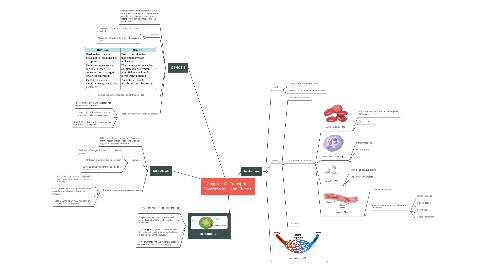
1. In Plants
1.1. 1. Water and mineral salts enters the root hair cells.
1.2. 2. Xylem vessels transport water and mineral salts from the roots to other parts of the plant.
1.3. 3. During photosynthesis, carbon dioxide from the surrounding air enter the leaves. Sugar is made in the leaves.
1.4. 4. Phloem transports the sugar produced in the leaves to other parts of the plant.
2. DIFFUSION
2.1. Diffusion is the net movement of particles from a region of higher concentration to a region of lower concentration.
2.2. Examples
2.2.1. Diffusion of Oxygen from red blood cells to organs
2.2.2. Diffusion of carbon dioxide into leaf
2.2.3. Diffusion of perfume from one side of a room to the other
2.3. Steps to answer questions on diffusion
2.3.1. Step 1: Write down which region has higher concentration of the specified molecule.
2.3.2. Step 2: Write down how the molecules will move (ie from where to where) via diffusion.
2.3.3. Step 3: Write down what happens after diffusion has taken place.
3. OSMOSIS
3.1. Osmosis is the net movement of water molecules from a region of higher water potential to a region of lower water potential through a partially permeable membrane.
3.2. Examples
3.2.1. Movement of water into the roots from soil in a plant
3.2.2. Movement of water into or out of a visking tubing
3.3. Difference between Osmosis and Diffusion
3.4. Steps to answer questions on osmosis
3.4.1. Step 1: Write down which region has higher water potential.
3.4.2. Step 2: Write down how the water molecules will move via osmosis.
3.4.3. Step 3: Write down what happens after osmosis has taken place.
4. In Humans
4.1. Heart
4.1.1. Pumps Blood around the Body
4.1.2. Walls of the heart are made of muscles
4.2. Blood
4.2.1. Transports substances
4.2.2. 4 components of blood
4.2.2.1. Red Blood Cells
4.2.2.1.1. transports oxygen (through haemoglobin) TO organs
4.2.2.1.2. has no nucleus
4.2.2.2. White Blood Cells
4.2.2.2.1. fights infections
4.2.2.2.2. has a nucleus
4.2.2.3. Platelets
4.2.2.3.1. clots blood at wound sites
4.2.2.3.2. They are cell fragments
4.2.2.4. Plasma
4.2.2.4.1. the liquid component
4.2.2.4.2. contains mostly water with dissolved substances
4.2.3. It is a tissue
4.3. Blood Vessels
4.3.1. Carries Blood around the body
4.3.1.1. arteries
4.3.1.1.1. carries blood AWAY from the heart
4.3.1.1.2. pumped out of the heart has high pressure
4.3.1.1.3. walls of arteries are thick to withstand the high pressure
4.3.1.2. veins
4.3.1.2.1. Capillaries will merge into veins
4.3.1.2.2. carry blood INTO the heart
4.3.1.2.3. Thinner walls than arteries as pressure is low
4.3.1.2.4. have valves to prevent blood from flowing backwards
4.3.2. capillaries
4.3.2.1. Arteries will branch into capillaries
4.3.2.2. Capillaries are very close to the cells in the body
4.3.2.3. Oxygen and nutrients in the capillaries will move into the cells surrounding the capillaries
4.3.2.4. Carbon dioxide and waste products will move from the cells into the capillaries
4.3.2.5. only one cell thick
4.3.3. How Blood Flows
